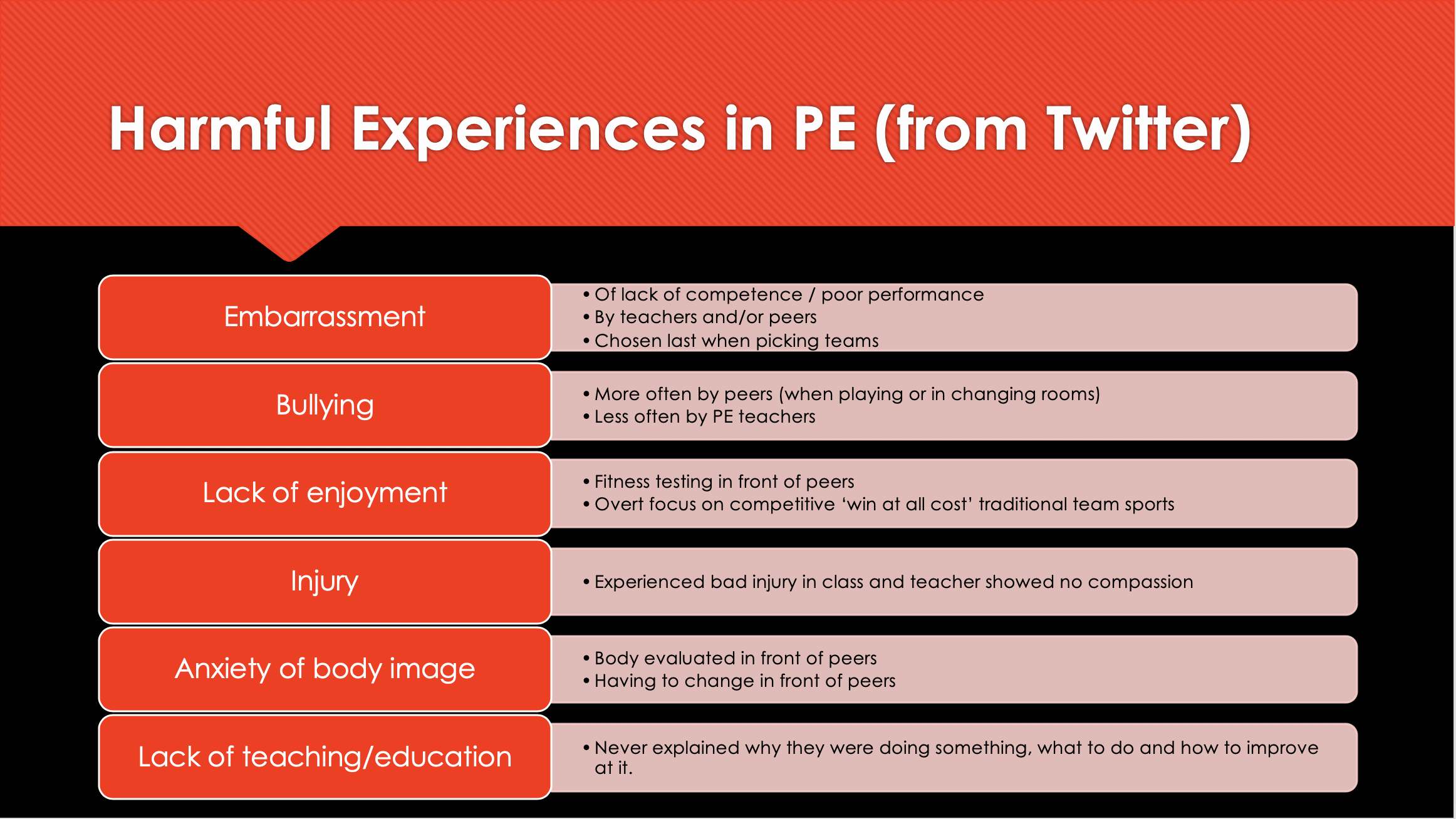How can we improve the provision of PE?
My initial response to that question as a novice teacher was what could I add. What new sports can I include in the curriculum that children might enjoy? What new initiatives, like the Daily Mile, can I implement that will get children moving more? What new teaching methods could I employ that improve the children’s learning, engagement and enjoyment of the subject? Improvement for me, and for those that managed me, was always about more. It was a way that I could prove my value. I was addicted to addition.
As I developed as a teacher and gained a broader perspective I saw that by focusing my attention on the new and novel I was overlooking my practices that created harmful PE experiences. These experiences are powerful, memorable and can directly influence future involvement in movement, sport and physical activity.
What are harmful experiences? Twitter can provide some possible answers. By diving into the replies to the three threads below about PE I looked for comments that linked a specific experience of PE to their current lack of participation in physical activity.
Why is/was PE the only subject in which humiliation was considered part of the learning process? In my school Mr Mulkerrin made us line up, take our tops off, and he walked down the line announcing whether or not we had soft bellies or the flat muscular ones he preferred. https://t.co/6MNzJfl5A4
— Matthew Sweet (@DrMatthewSweet) October 5, 2018
P.E. class sucks. The end. Exercise is the best medicine but that is not P.E. class. You know what P.E. taught me and my kids? To hate exercise and that special joy of coming in last. https://t.co/tZT6I8Qdv2
— Jennifer Gunter (@DrJenGunter) February 2, 2019
PE teachers can wreck your health. Dr Anne Elliott found that bad experiences in school PE actively deterred people from taking exercise in later life & led to a state of alienation from their own bodies. https://t.co/jrxqbGjMgD
— Adrian Bott (@Cavalorn) April 11, 2020
They were not hard to find and I stopped around 150 comments. The results are in the graphic below. The most frequent harmful experience in PE (almost 1 in 3), was attributed to embarrassment either by teachers or by their peer group with consistently being picked last for teams clearly something which impacts on a individual’s self efficacy with regards to sport. Experiences of bullying (in the changing rooms by peers), lack of enjoyment (caused by compulsory fitness tests set up for individuals to fail), injury (which wasn’t believed) and anxiety of body image (due to teenagers having to change in front of each other) were of similar frequency. These are similar to the themes Mathew Ladwig and colleagues found in their research about adults memories of PE and how they relate to their attitude to physical activity.

How does knowing this help with the improvement of PE? Via Negativa is Latin phrase from Christian Theology. As God is beyond our comprehension, its is easier to describe what he is not than what he is. The polymath Nassim Taleb uses the term in his book Antifragile to describe a process of where individuals and organisations (in this case PE) can achieve progress through subtraction.
“So the central tenet of the epistemology I advocate is as follows: we know a lot more what is wrong than what is right, or phased according to the fragile/robust classification, negative knowledge (what is wrong, what does not work) is more robust to error than positive knowledge (what is right, what works). So knowledge grows by subtraction much more than by addition – given that what we know today might turn out to be wrong but what we know to be wrong cannot turn out to be right, at least not as easily.”
Obesity, sedentary behaviour and a lack of character are put forward as crises for PE to solve. Harm Free PE says the crisis we first need to solve is the one of our own making – that of harmful experiences that make children turn their backs on movement. There is an asymmetry at play in PE that we need to be fully aware of. That a single harmful experience can undo years of hard work as it becomes an enduring memory that shapes people’s engagement in a physically active life. No matter what additions that we look to implement into the curriculum, their benefit can be undone by a harmful experience. We don’t want people to look back at their experience of PE with shame, anger or anxiety.
The natural bias we have is towards positive action as it is hard to focus on how avoiding the downside is a plus. There is also the challenge in an age of performance management to prove your value through subtraction rather than addition. However if we focus on eliminating embarrassment, banishing bullying, nullifying a lack of enjoyment, removing injury and putting an end to anxiety within our subject we reduce the harmful experiences that put children off movement. This might not be the radical change that PE requires, but it is a realistic one. Whatever we decide to do to improve PE within our context, we need to be guided by the principle of doing no harm.

